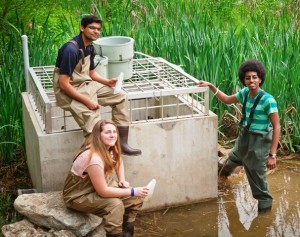Sullivan Park in Easton was named Pennsylvania’s 2014 Green Park of the Year thanks in part to Lafayette civil engineering students who installed a wetlands habitat there by first mitigating a serious water runoff problem and then planting native vegetation.
http://youtu.be/PsQ1ehVunkA
Although the City of Easton is the official recipient of the state’s top conservation award, the Bushkill Stream Conservancy, Northampton County Conservation District, and Lafayette all played a role in transforming the perpetually soggy park into a sustainable showcase that now serves as an outdoor classroom for area schools.
“It was great that there were many partners who put in a lot of effort to make this happen,” says David Brandes, associate professor of civil and environmental engineering, whose students began working on the project nearly 10 years ago.
The park, located at the edge of a steep slope in College Hill, was formerly the site of many flash floods that eroded the embankment, depositing mud and debris onto the sidewalks and yards of homes below. The stormwater runoff also created less than ideal conditions for the park’s baseball field.
“There were cattails growing in the outfield,” says Brandes. “As a parent, it’s not something you want to see.”
When Hurricane Ivan ripped through the Lehigh Valley in 2004, causing major property damage to the area, State Rep. Robert Freeman and the Bushkill Stream Conservancy, of which Brandes is a member, proposed developing a portion of the park into a constructed stormwater detention area.

Hassaan Khan ’13, Hannah Griesbach ’13, and Leikune Aragaw ’15 collect water samples and computer data at Sullivan Park to evaluate back in the engineering lab.
Brandes’ students then worked with the conservancy to produce an innovative solution to alleviate the runoff while preserving the natural aesthetics of the park. In 2009, the city received a Growing Greener Grant from the state Department of Environmental Protection and the plan was put in place.
Future classes of Lafayette students have since assisted in the project by regularly monitoring the site, helping to plant native vegetation, and by installing a V-notch weir, a triangular channel section that measures inflow.
“Every year in my Water Resources class we do a project based up there to analyze how well the system is performing,” says Brandes. “My students often find it gratifying to be involved in a local project where they can learn the history and be part of the solution to an existing problem.”

1 Comment
Wetlands recognition and restoration are ‘hot topics’ as America digs out of its recession. The public is going to want to have new homes and infrastructure, but realtors and builders are realizing that development cannot invade low-lying areas. As a matter of fact, the trend to fill wetlands and to build in the centers of stream valleys has to be reversed. The result will be forward-thinking community plans and tasteful platted construction sites. Wetland habitat is deliniated “on-the-ground” by distinct indicator plant species. Biologists are well suited in interest and background to do this field work.
There are decades of new wetlands work that will pay high salaries for well-trained engineers and biologists. Results will be more aesthetic and efficient communities. It is nice to see that this work is starting at Lafayette. Go, Pards!
Comments are closed.